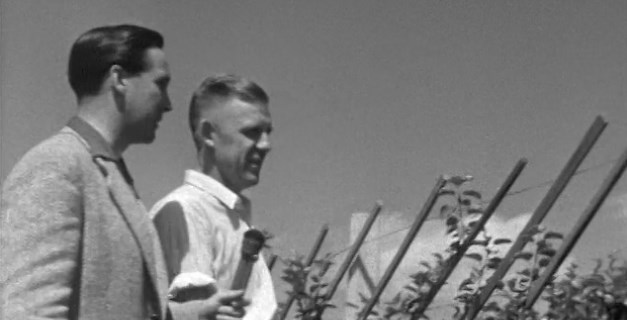iN VIDEO: Dwarf apple trees in the Okanagan in the spotlight of this 1955 film

Long before dwarf apple trees became the standard in the Okanagan, the National Film Board was showing the way.
In 1955, Julian Biggs, who went on to garner an Academy Award nomination for his 1966 film on Bill Mason called ‘Paddle to the Sea,’ dropped in to what was then called the Summerland Experimental Farm to shoot a film called ‘Dwarf Apple.’
“The size of an apple tree can be controlled by the size of the root on which it’s grown,” Dr. Don Fisher, head of pomology at the station at the time, explained to Biggs in the 5.5 minute black and white film.
Fisher went on to point to a system of concrete posts planted in the ground with steel wires strung at 3.5 and 6 foot heights to support the tiny trees.
READ MORE: iN VIDEO: That '70s documentary of Penticton graduation
Another method of support was called the hedgerow, where trees were planted twice as close together with their branches intertwined for support.
Then there was the trellis method that was attractive but not practical on a large scale.
“You’ll notice the very good exposure of the apples to the light,” Fisher demonstrated. “We get wonderful red apples with this method of culture. This is particularly important in climates where light may be somewhat lacking. If you’re in a cooler climate, you could use this method against a wall and the heat would be reflected back from the wall onto the fruit.”
He admits it’s too expensive and takes too many trees per acre to be feasible in orchards.
“For a home gardener, of course, it’s a different matter,” Fisher said. “If you want to grow a few trees and get good colour, something that’s easy to pick, easy to spray, I think this is an ideal thing.”
Biggs speculates about creating a rose garden effect with dwarf apple trees on either side that join together at the top to form an arch.
Biggs went on to write, direct and sometimes produce 17 other National Film Board features ranging from ‘With the Canadians in Korea’ in 1952 to ‘A Little Fellow from Gambo – The Joey Smallwood Story’ in 1970.
He was born in Port Perry, ON in 1920 and died in Montreal in 1972, joining the NFB in 1951. He served as English Production director for the board in the late 1960s, according to the Canadian Film Encyclopedia website.
He produced more than 100 films between 1953 and 1970 including “seminal films of the era” such as ‘Buster Keaton Rides Again,’ ‘High Steel’ and ‘The Railrodder,’ all in 1965.
READ MORE: iN VIDEO: Here’s a unique view of road travel through the Okanagan in 1966
For his part, Fisher was born and raised in Kelowna and started in the pomology section of the research station on a temporary basis in 1933. He rose to be director of the entire station in 1971 before retiring in 1974.
As a researcher he looked into things like the connection between how ripe apples were when they were picked and how that impacted their storage.
As director of the research station, one of the major policies he introduced was flexible work hours, according to Agriculture Canada’s ‘History of Summerland Research Station, 1914-1985.’
As for the dwarf apples, it wasn’t until the 1990s that they really started taking over the orchards in the Okanagan.
To contact a reporter for this story, email Rob Munro or call 250-808-0143 or email the editor. You can also submit photos, videos or news tips to the newsroom and be entered to win a monthly prize draw.
We welcome your comments and opinions on our stories but play nice. We won't censor or delete comments unless they contain off-topic statements or links, unnecessary vulgarity, false facts, spam or obviously fake profiles. If you have any concerns about what you see in comments, email the editor in the link above.


